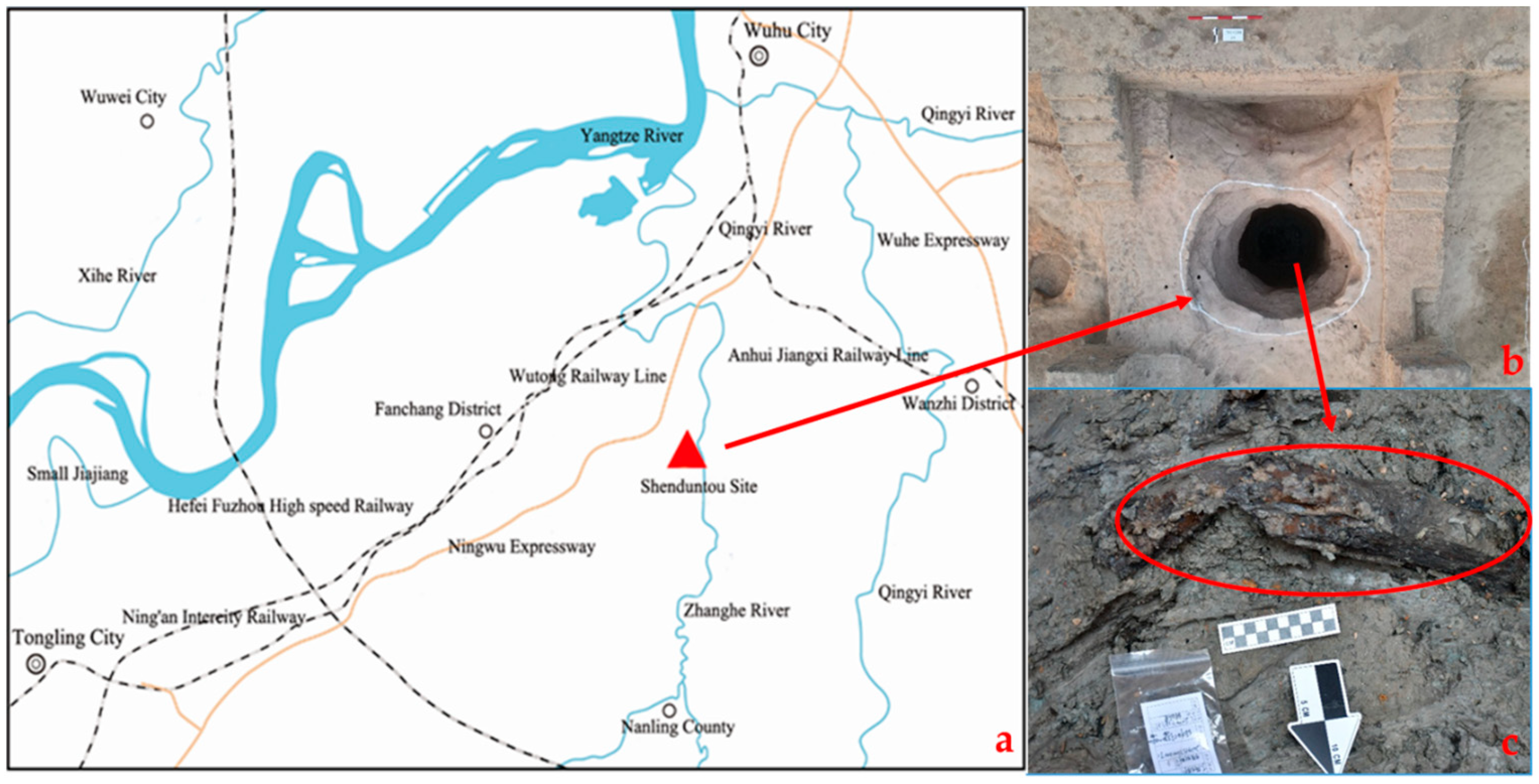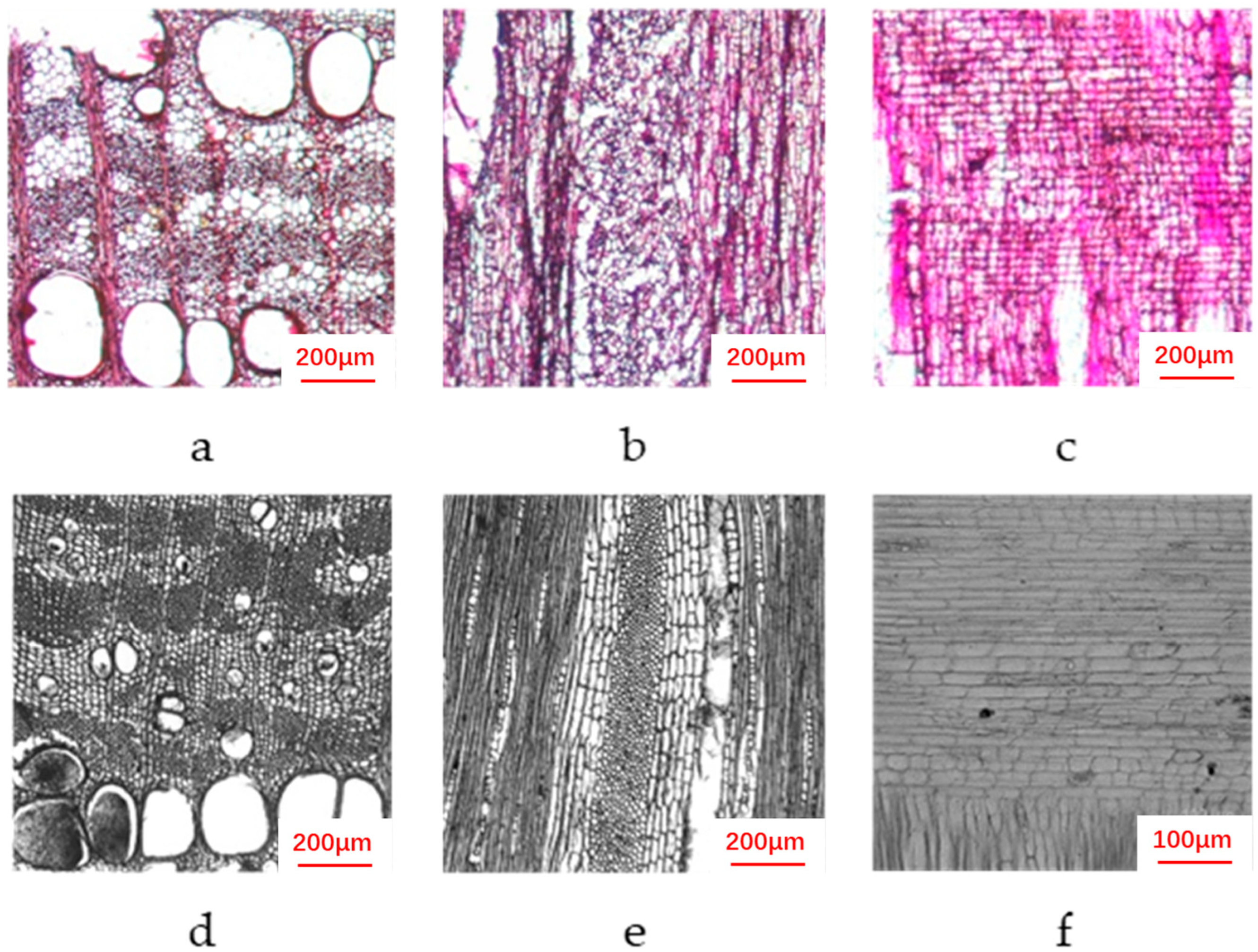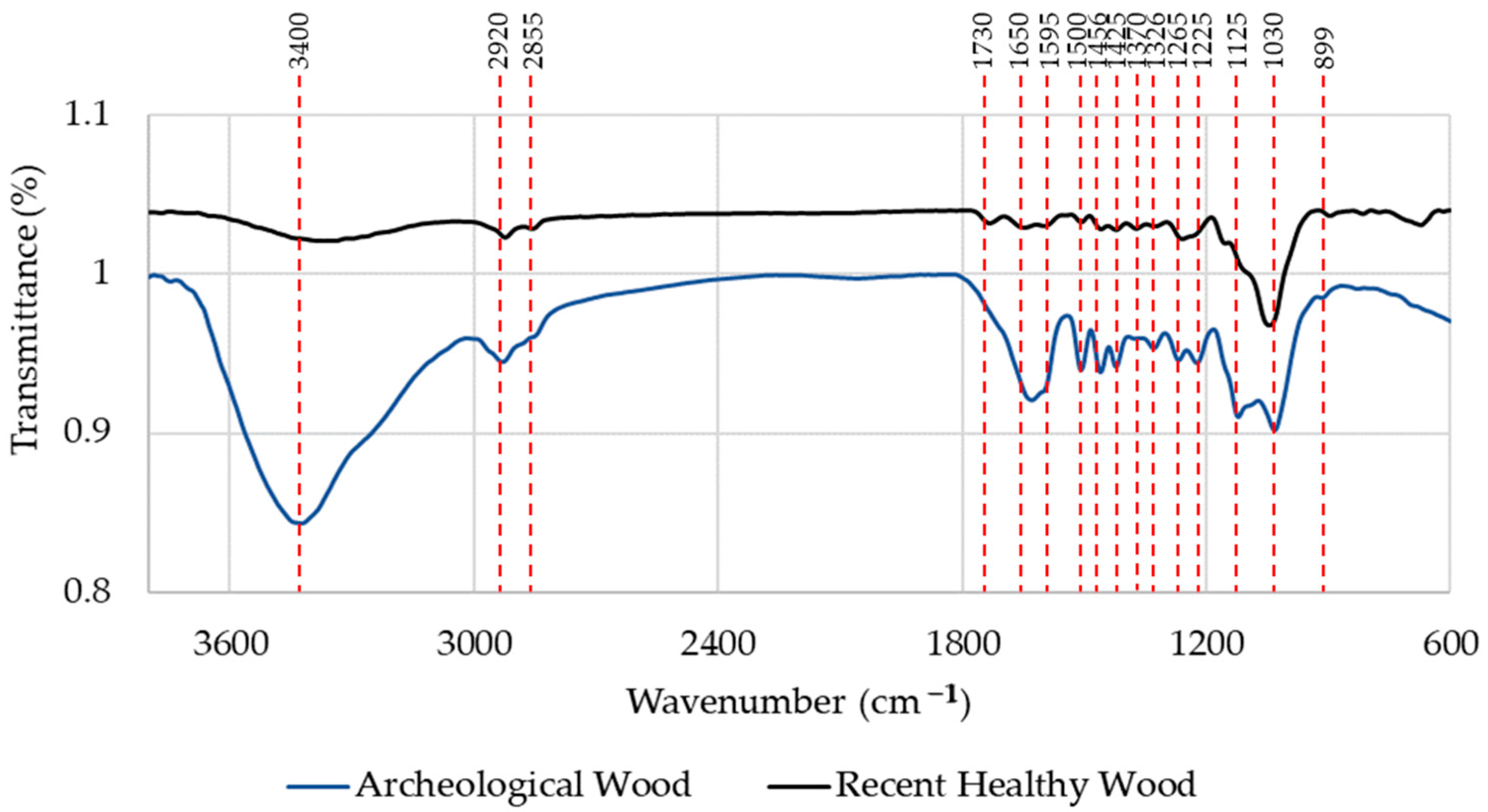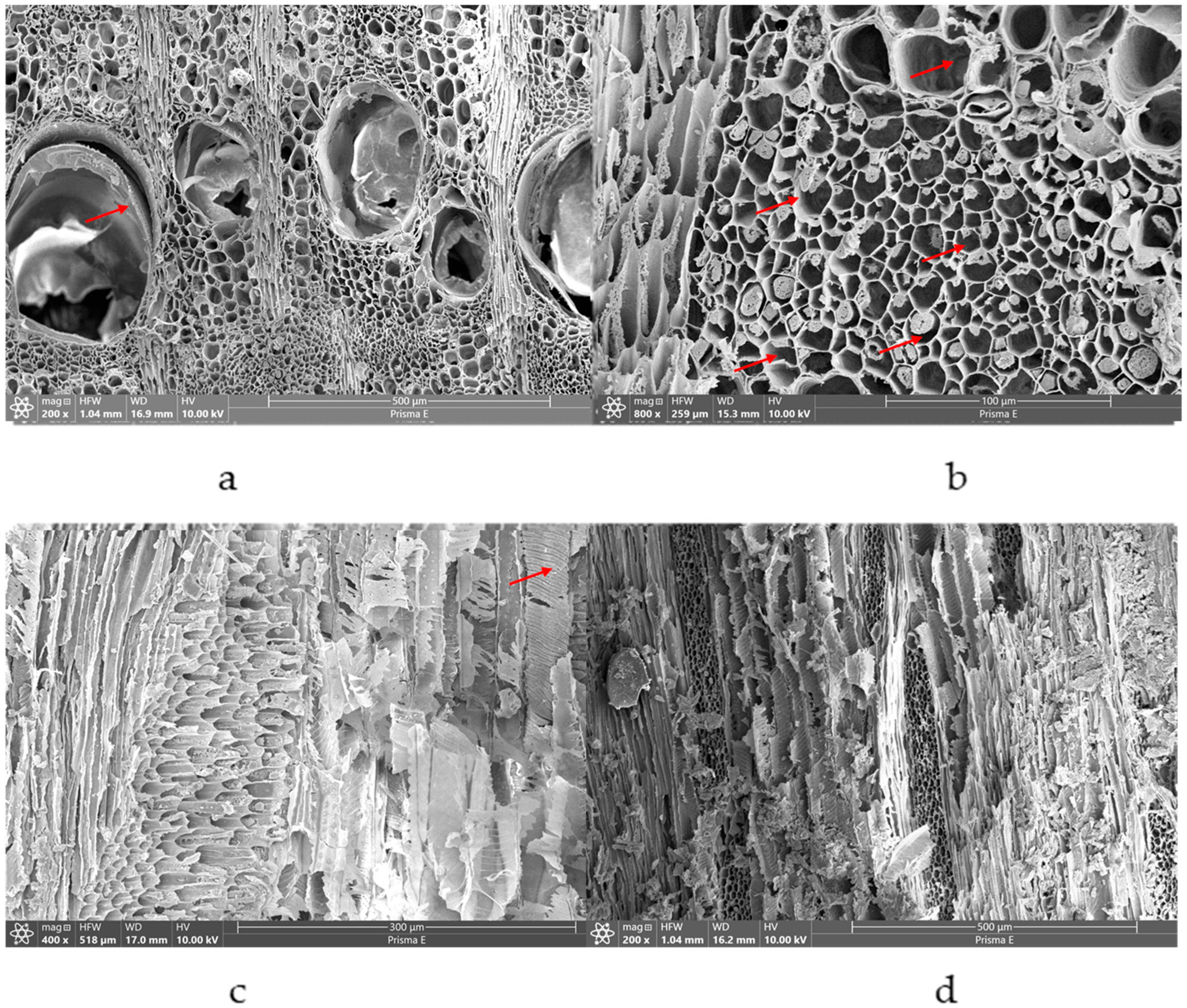1. Introduction
Located on the western bank of the Zhanghe River in Fanchang District, Wuhu City, Anhui Province, the Shenduntou Site is a Zhou Dynasty settlement and handicraft production centre of significant academic value. Its core northwestern terrace (approx. 1500 m2) was protected by a moat and earthen walls. Systematic excavation revealed three developmental phases: Phase I (mid-late Western Zhou) functioned as a settlement featuring pile-dwellings and domestic artefacts; Phase II (early-mid Spring and Autumn period) reached its zenith as a fortified regional bronze-casting workshop centre; Phase III (late Spring and Autumn period) witnessed the cessation of bronze production and settlement decline.
A key Phase I feature is Well J1 (opening beneath Layer ⑦ of TN04E04, depth: 440 cm), which preserves a rare square wooden frame (100 cm E-W × 80 cm N-S), bottom planking, carbonised wood remnants, and supporting stakes—representing exceptionally rare example of preserved Western Zhou timber in southern Anhui. Artefacts recovered from the well, including pottery tripods, bronze knives, and jade objects, combined with typological analysis of associated pottery, securely date it to the mid-late Western Zhou period.
The discovery of wooden components in Well J1 is of profound significance (
Figure 1). It not only directly relates to the water resource utilisation techniques, architectural craftsmanship, and woodworking traditions of the ancient inhabitants of the Western Zhou Dynasty, but its unique preservation state (such as charring traces) also provides critical insights into the burial process and site transformation. Conducting systematic timber species identification and performance evaluation of such precious remains serves as the cornerstone for subsequent in-depth research.
Precise wood identification can elucidate resource preferences and environmental adaptation strategies of ancient populations, providing direct evidence for reconstructing paleovegetation patterns, potential timber trade, and anthropogenic impacts on the environment [
1,
2,
3]. Simultaneously, performance evaluations such as decay resistance, microstructural deterioration, and mechanical strength support insights into material selection logic and technical knowledge [
4,
5,
6]. Recent studies on prehistoric and historical wooden remains demonstrate how such integrative approaches can reconstruct human–wood–environment interaction and craft choices [
7,
8,
9,
10]. The wood from Well J1, exhibiting carbonization and intact mortise-and-tenon framing, offers a unique lens for exploring early technological innovation and emergency abandonment events at the Shenduntou site.
Therefore, this paper focuses on the ancient wooden artefacts excavated from Well J1 at the Shenduntou Site, employing multidisciplinary approaches to conduct timber species identification and performance evaluation. This work is essential not only for interpreting the construction techniques and functionality of Well J1 itself and reconstructing local woodworking craftsmanship during the Western Zhou period, but also for supporting broader interpretations of settlement evolution, bronze production transitions, and human–environment dynamics in the lower Yangtze region during the Zhou Dynasty.
2. Materials and Methods
2.1. Materials
This study examines the square wooden well frame from the lower section of Well J1 (Excavation Unit TN04E04) at the Shenduntou site in Fanchang, Anhui Province. The samples, recovered at a burial depth of 440 cm, exhibited charred or decayed conditions and date to Phase I of the mid-to-late Western Zhou period (9th–8th centuries BCE). Modern healthy wood of the same species from the same region was collected as a reference group for comparative analysis of degradation patterns, following recent practices in paleobotanical material comparison [
11,
12]. Archaeological samples were pretreated in distilled water and a 0.5% (
w/
v) solution of 2-methyl-4-isothiazolin-3-one (MIT) for 48 h to inhibit microbial activity [
13].
2.2. Wood Species Identification Method
Species identification was conducted via anatomical microscopy in accordance with Chinese National Standard GB/T 29894-2013 [
14]. Decayed wood was embedded in 15% polyethylene glycol (PEG-1500, Sigma-Aldrich, St. Louis, MO, USA) and vacuum-treated at 60 °C for 72 h [
15]. Slices with a thickness of 15 μm were sectioned along transverse, radial, and tangential planes and stained with 1% aqueous safranin before ethanol dehydration and xylene clearing. Observations under Nikon Eclipse E100 optical microscope (Nikon Corporation, Tokyo, Japan) at 100× magnification were compared with reference spectra from the Chinese Wood Chronicles and the CAS Wood Database [
16].
2.3. Performance Analysis
2.3.1. Maximum Water Content (MWC) Test
Both archaeological and modern samples (1 cm × 1 cm × 1 cm cubes,
n = 5 per group) were immersed in distilled water for 14 days to reach saturation equilibrium before measuring saturated mass (Wsat) and oven-dry mass (W
0). Saturated mass was measured using an electronic balance (Mettler Toledo XS205, Mettler Toledo, Greifensee, Switzerland; precision: 0.1 mg). All samples were then oven-dried at 103 °C to constant weight to determine W
0. Maximum water content was calculated according to Formula (1), following ASTM D4442 standard procedures [
17,
18]:
2.3.2. X-Ray Diffraction (XRD) Analysis
Archaeological and modern wood samples (n = 3 replicates per group) were oven-dried to an absolutely dry state, ground into powder, and sieved to collect particles finer than 200 mesh for analysis. X-ray diffraction was conducted using a Rigaku SmartLab 9 kW diffractometer (Rigaku Corporation, Tokyo, Japan) with a Cu-Kα radiation source (λ = 1.5406 Å). The scanning range was set from 5° to 40° (2θ), with a step size of 0.02° and a scanning speed of 2°/min.
The crystallinity index (CrI) of cellulose was calculated based on the Segal method using Equation (2) [
19]
where I
002 is the intensity of the crystalline cellulose peak (2θ ≈ 22.5°), and I
am is the intensity of the amorphous background (2θ ≈ 18°). This method is widely used in cellulose degradation assessments in archaeological wood [
20].
2.3.3. Fourier Transform Infrared Spectroscopy (FTIR) Analysis
Samples were ground to 200-mesh powder (
n = 3 replicates per group) for FTIR-ATR analysis. FTIR-ATR was performed using Thermo Nicolet iS50 (Thermo Fisher Scientific, Waltham, MA, USA) with a resolution of 4 cm
−1 over the range of 4000–400 cm
−1 (32 scans per spectrum). All spectra were baseline corrected and normalised. This method allows non-destructive detection of lignin–carbohydrate matrix changes, consistent with recent heritage wood studies [
21].
2.3.4. Scanning Electron Microscopy (SEM) Observation
Sectioned samples were sputter-coated with gold (10 nm) using Hitachi E-1045 (Hitachi, Tokyo, Japan), then imaged using a Hitachi SU8010 FE-SEM under 5 kV. Focus was placed on tracheid wall collapse, pit deformation, and microbial etching, key parameters in wood conservation diagnostics [
12,
16,
21].
3. Results and Discussions
3.1. Wood Species Identification
Macroscopic features and microscopic structures of wood are crucial for species identification. Despite the severe decay of the archaeological wood sample, it was still possible to conduct a microscopic anatomical analysis (
Figure 2). The transverse section of the wooden component from Well J1 (the well frame) exhibits characteristics typical of ring-porous wood. The material appears blackened and shows signs of degradation. The transverse section (
Figure 2a) displays distinct growth rings with 4–6 earlywood vessels/mm
2 (160–250 μm diameter) arranged in 1–2 radial rows, transitioning sharply to smaller latewood vessels (30–80 μm diameter) in radial multiples of 2–3, accompanied by vasicentric parenchyma forming complete sheaths 2–3 cells wide and banded parenchyma creating wavy tangential lines (3–5 cells wide) at growth boundaries. Tangential sections (
Figure 2b) reveal uniseriate rays (4–10 cells high × 15–25 μm wide) alongside multiseriate rays (3–15 cells wide × 40–100 cells high) with prominent sheath cells, vessel-ray pits with reduced borders (5–8 μm diameter), and occasional spiral thickenings in vessels. Radial sections (
Figure 2c) exhibit heterogeneous Type II ray tissue with procumbent body cells and 1–4 rows of square/upright marginal cells, simple perforation plates, alternate intervessel pits (7–10 μm diameter) with lenticular apertures, and crystals in chambered axial parenchyma cells [
22,
23].
Through detailed comparison with the InsideWood database, the archaeological wood was conclusively identified as
Firmiana simplex (L.), despite showing characteristic degradation patterns including enlarged axial parenchyma (40–60 μm vs. modern 20–30 μm) and reduced latewood vessels (3–5/mm
2 vs. 8–12/mm
2) [
21,
24]. This selection reflects the Zhou Dynasty’s sophisticated understanding of material properties, as
F. simplex’s water resistance (class III) and mechanical strength (Janka hardness 2300 N) made it ideal for well construction [
25]. Importantly, this species held broader significance in early Chinese woodcraft: while elite constructions used imported Pterocarpus and northern sites preferred Ulmus for burial chambers,
F. simplex served as a keystone species for hydraulic systems in the Yangtze basin due to its local availability and unique performance when waterlogged. Historical records further indicate its cultural importance as a symbolic landscape marker, as it was often planted near ceremonial sites [
26,
27]. These findings demonstrate how Zhou material selection balanced practical engineering needs with ecological and cultural considerations, offering new insights into early Chinese technological adaptation and resource management strategies.
3.2. Property Evaluation
3.2.1. Hydration State Analysis
Hydration state analysis revealed the archaeological
Firmiana simplex specimens exhibited a maximum water content of 1100% ± 85%, representing a 9.2-fold increase over modern samples (120% ± 8%) and exceeding IAWA degradation thresholds by 2.75× [
28]. This extreme water content is attributed to prolonged immersion in a groundwater-saturated, anoxic environment, which promotes extensive hydrolysis of hemicellulose and partial delignification. These processes dismantle the microfibril framework of the secondary wall, expand nanopores, and enhance capillary uptake, as confirmed by previous waterlogged wood studies [
11,
29].
This confirms that the wood has reached an advanced degradation state, with loss of internal cohesion and collapse of cellulose crystallites. In this context, successful conservation demands low-surface-tension consolidants, such as hydroxyethyl methacrylate (HEMA) or nano-SiO
2 dispersions, capable of diffusing into macroporous zones to reinforce weakened cell walls [
30].
3.2.2. Crystalline Structure Assessment
XRD analysis (
Figure 3) demonstrates significant structural degradation in the archaeological wood compared to modern
Firmiana simplex. The modern sample exhibits characteristic cellulose diffraction features—a broad amorphous halo at 2θ≈18° (FWHM = 3.2°) and a crystalline peak at 2θ ≈ 22.5° (FWHM = 2.8°), with intensities of 35,350 and 48,483, respectively. In contrast, the archaeological sample shows substantial peak broadening (FWHM increase > 40%) and intensity reduction (18,562 at 22.5°), resulting in a marked crystallinity index decrease from 52.8% to 16.1% (
p < 0.01), representing a 69.5% reduction [
31].
These XRD patterns indicate three fundamental degradation processes: (1) disruption of hydrogen bond networks between cellulose chains, (2) fragmentation of crystalline lamellae structures, and (3) a consequent 60%–70% loss in mechanical strength. These changes align with established models of oxidative and microbial decay in waterlogged archaeological wood [
12,
30], highlighting the need for consolidation treatments that specifically address crystalline structure destabilisation in preservation strategies.
3.2.3. FTIR Spectroscopic Analysis of Wood Degradation
FTIR analysis (
Figure 4) revealed substantial chemical transformations in the archaeological wood resulting from prolonged burial. The complete disappearance of the 1730 cm
−1 C=O band confirms near-total hemicellulose degradation, while the 75%–80% reduction in the 1370 cm
−1 cellulose signature demonstrates significant polysaccharide breakdown. Concurrently, the 1.8–2.2× enhancement of 1595/1500 cm
−1 aromatic bands indicates lignin enrichment, and the 3.5× increase in 1650 cm
−1 oxidative products reveals advanced chemical alteration. These changes are accompanied by pronounced broadening of the 3400 cm
−1 O-H stretching band, reflecting both increased hydrophilicity from porosity development and oxidative reactions [
4,
31,
32]. The spectral evolution follows characteristic anaerobic degradation pathways, with selective polysaccharide decomposition and lignin preservation creating a fragile, porous matrix [
21,
33]. These molecular-level transformations correlate directly with the observed macrostructural deterioration and provide critical benchmarks for conservation treatment development.
The spectral evolution follows characteristic Type II (anaerobic) hydrolysis pathways, featuring selective polysaccharide decomposition and lignin preservation [
22,
34]. Additional fungal-mediated lignin modification and secondary mineralisation effects are evident from the enhanced syringyl/guaiacyl peaks (1326, 1225, 1125 cm
−1) [
33,
34,
35,
36]. These molecular-level transformations directly correlate with the observed macrostructural fragility, explaining the mechanical property deterioration while providing critical benchmarks for evaluating conservation treatment efficacy.
3.2.4. SEM Microstructural Observation
Scanning Electron Microscopy (SEM) images (
Figure 5) demonstrate multiscale microstructural deterioration of the archaeological wood. Vessel walls are thinned, and pit membranes are entirely absent—both being classic indicators of long-term chemical hydrolysis and microbial attack [
37,
38]. The collapse of fibre lumina and delamination of the S2 wall layer indicate depolymerization of the secondary wall and structural collapse, as indicated by the arrows in
Figure 5a,b, consistent with severe burial-induced decay.
Irregular infillings in the lumen may correspond to microbial residues or mineral precipitates, reflecting secondary mineralization often observed in waterlogged archaeological timbers [
39]. Radial sections reveal disrupted pit outlines, and tangential sections exhibit wall fractures during sample prep, signifying high brittleness and mechanical degradation. These findings strongly support the notion that both biological and geochemical degradation processes are responsible for the irreversible collapse of the cell wall structure.
4. Conclusions
This study provides new insights into Western Zhou wood craft through the analysis of Firmiana simplex timbers from Well J1 at Shenduntou. The identification of this water-resistant species reflects intentional selection of local materials for hydraulic structures, demonstrating sophisticated environmental adaptation. Advanced degradation patterns, including cellulose crystallinity loss and lignin enrichment, reveal complex post-depositional processes that inform both archaeological interpretation and conservation practice. The findings illuminate the following: (1) Zhou-era technological knowledge about material selection, (2) long-term wood-water-mineral interactions in burial environments, and (3) urgent conservation needs for similarly degraded archaeological wood. This work establishes a framework for understanding human–environment dynamics in early Chinese settlement systems while contributing to heritage preservation science.
Author Contributions
Conceptualization, L.X. and Z.W.; methodology, L.X.; software, W.Y.; validation, L.X., M.L. and X.L.; formal analysis, L.X.; investigation, L.X.; resources, Z.W.; data curation, W.Y.; writing—original draft preparation, L.X.; writing—review and editing, M.L.; visualisation, W.Y.; supervision, Z.W.; project administration, Z.W. All authors have read and agreed to the published version of the manuscript.
Funding
This research received no external funding.
Data Availability Statement
The original contributions presented in this study are included in the article. Further inquiries can be directed to the corresponding author.
Conflicts of Interest
The authors declare no conflicts of interest.
References
- Meier, E.W. Identifying and Using Hundreds of Woods Worldwide; Wood Database: Springboro, OH, USA, 2015. [Google Scholar]
- Shi, S.; Xiao, C.; Li, Z.; Wang, Y.; Wang, H.; Niu, Z. Tree-ring Dating of the Construction of the Yinshan Tomb in Shaoxing, Zhejiang Province: A Preliminary Study. Sci. China Earth Sci. 2025, 68, 1960–1973. [Google Scholar] [CrossRef]
- Nong, K.; Zhang, G.; Wang, L.; Cheng, Y.; Jiang, H. Prehistoric Wooden Bows and Arrows in the Turpan Basin, Northwest China: Wood Selection and Utilization in a Mosaic Landscape. Archaeometry 2023, 65, 506–524. [Google Scholar] [CrossRef]
- Wang, D.; Dong, W.; Cao, L.; Zhu, C.; Yan, J. Deterioration Mechanisms of Archaeological Wood inside the Bronze Parts of Excavated Chariots from the Western Han Dynasty. J. Cult. Herit. 2023, 63, 60–70. [Google Scholar] [CrossRef]
- Yang, X.; Li, C.; Wang, L.; Yang, C.; Zhang, S.; Gao, J.; Qiu, J. The Characteristics of Ancient Residence Wood from the Qing Dynasty in Yunnan Province. Coatings 2024, 14, 200. [Google Scholar] [CrossRef]
- Guo, Z.; Qi, Q.; Zhang, S.; Chen, W.; Yang, L.; Zhang, Y. Characterization of Spatial and Temporal Evolution of Earthen Sites Construction Technology in China Based on GIS. Res. Sq. 2025. [Google Scholar] [CrossRef]
- Martin, D.L.; Harrod, R.P.; Pérez, V.R. Bioarchaeology: An Integrated Approach to Working with Human Remains; Springer Science & Business Media: Berlin/Heidelberg, Germany, 2013. [Google Scholar]
- Wang, R.; Shang, Y.; Cheng, Y.; Pan, B.; Jiang, H. Wood Utilization and Cultural Integration Indicated by Woodware Excavated from Ancient Turpan, Xinjiang. npj Herit. Sci. 2025, 13, 184. [Google Scholar] [CrossRef]
- Zhang, L.; Liu, C.; Zhou, T. Experimental Study on Mechanical Properties of Column Foot of Ancient Timber Structures–Take the Drum-Shaped Plinth as an Example. Structures 2022, 40, 1002–1013. [Google Scholar] [CrossRef]
- Ma, P. The Political Symbolism of Chinese Timber Structure: A Historical Study of Official Construction in Yingzao-Fashi. Ph.D. Dissertation, University of New South Wales, Sydney, Australia, 2020. [Google Scholar] [CrossRef]
- Liu, X.; Tu, X.; Xu, X.; Ma, W.; Huang, H.; Varodi, A.M. Characteristics of Ancient Ship Wood from Taicang of the Yuan Dynasty. Materials 2022, 16, 104. [Google Scholar] [CrossRef] [PubMed]
- Guo, J.; Xiao, L.; Han, L.; Wu, H.; Yang, T.; Wu, S.; Yin, Y. Deterioration of the Cell Wall in Waterlogged Wooden Archaeological Artifacts, 2400 Years Old. IAWA J. 2019, 40, 820–844. [Google Scholar] [CrossRef]
- Zhou, Y.; Wang, K.; Chen, X.; Hu, D. Alterations in the Anatomy and Chemical Structure of Archaeological Wood from a Tomb of Northern China due to Different Fungal Rots. Wood Res. 2020, 65, 757–770. [Google Scholar] [CrossRef]
- GB/T 29894-2013; Test Method for Moisture Content of Wood and Bamboo—Oven-Dry Method. China Standards Press: Beijing, China, 2013.
- Jeremic, D. Diffusion and Equilibrium Amount of Polyethylene Glycol in Wood Cell Walls. Ph.D. Thesis, University of Toronto, Toronto, ON, Canada, 2007. [Google Scholar]
- Mi, X.; Li, T.; Wang, J.; Hu, Y. Evaluation of Salt-Induced Damage to Aged Wood of Historical Wooden Buildings. Int. J. Anal. Chem. 2020, 2020, 8873713. [Google Scholar] [CrossRef] [PubMed]
- ASTM D4442-20; Standard Test Methods for Direct Moisture Content Measurement of Wood and Wood-Based Materials. ASTM International: West Conshohocken, PA, USA, 2020.
- Han, L.; Xi, G.; Dai, W.; Zhou, Q.; Sun, S.; Han, X.; Guo, H. Influence of Natural Aging on the Moisture Sorption Behaviour of Wooden Structural Components. Molecules 2023, 28, 1946. [Google Scholar] [CrossRef] [PubMed]
- Guo, J.; Chen, J.; Meng, Q.; Ploszczanski, L.; Liu, J.A.; Luo, R.; Jin, T.; Siedlaczek, P.; Lichtenegger, H.C.; Yin, Y.; et al. Molecular and Crystal Structures of Cellulose in Severely Deteriorated Archaeological Wood. Cellulose 2022, 29, 9549–9568. [Google Scholar] [CrossRef]
- Mi, X.; Li, Y.; Qin, X.; Li, J. Effects of Natural Weathering on Aged Wood from Historic Wooden Building: Diagnosis of the Oxidative Degradation. Herit. Sci. 2023, 11, 109. [Google Scholar] [CrossRef]
- Li, R.; Zhang, Z.; Jiao, L.; Yin, Y.; Tie, F.; Sun, M. Combining Microscale ATR-FTIR and Chemometrics to Interpret Degradation Characteristics of Earlywood, Latewood, and Compression Wood in Waterlogged Archaeological Pine Wood. Herit. Sci. 2024, 12, 387. [Google Scholar] [CrossRef]
- Esteban, L.G.; de Palacios, P.; Gasson, P.; García-Iruela, A.; García-Fernández, F.; García-Esteban, L. Hardwoods: Anatomy and Functionality of Their Elements—A Short Review. Forests 2024, 15, 1162. [Google Scholar] [CrossRef]
- Kandpal, V.; Gupta, P.; Gupta, S. Advances in the Wood Anatomical Studies with Innovations in Microscopy: A Review. In Asia-Pacific Forest Sector Outlook: Innovative Forestry for a Sustainable Future; CIFOR: Bogor, Indonesia, 2021. [Google Scholar] [CrossRef]
- Ma, L.; Liu, Y.; Zhao, H. The Timber Trees of China; China Forestry Publishing House: Beijing, China, 2020. [Google Scholar]
- Crang, R.; Lyons-Sobaski, S.; Wise, R. Wood: Economics, Structure, and Composition. In Plant Anatomy; Springer: Cham, Switzerland, 2018; pp. 285–304. [Google Scholar] [CrossRef]
- Watkins, C. Trees, Woods and Forests: A Social and Cultural History; Reaktion Books: London, UK, 2014. [Google Scholar]
- Cai, W.; Tai, H.-C. Three millennia of tonewood knowledge in Chinese guqin tradition: Science, culture, value, and relevance for Western lutherie. Savart J. 2018, 1, 1–24. [Google Scholar]
- High, K.E.; Penkman, K.E.H. A Review of Analytical Methods for Assessing Preservation in Waterlogged Archaeological Wood and Their Application in Practice. Herit. Sci. 2020, 8, 83. [Google Scholar] [CrossRef]
- Ibrahim, S.; Grenni, P.; Mancini, L.; Voltolini, M.; Abdel-Fatah, H.M.K.; Refaat, A.; Atwa, D.M. Multifactorial Analysis of Wood Deterioration in Ancient Egypt: A Case Study of Khufu’s Second Solar Boat. Appl. Sci. 2025, 15, 3952. [Google Scholar] [CrossRef]
- Zhang, J.; Li, Y.; Ke, D.; Wang, C.; Pan, H.; Chen, K.; Zhang, H. Modified Lignin Nanoparticles as Potential Conservation Materials for Waterlogged Archaeological Wood. ACS Appl. Nano Mater. 2023, 6, 7821–7834. [Google Scholar] [CrossRef]
- Gao, Q.; You, J.; Liao, X.; Wang, Z. Identification and Analysis of Ancient Ship Wood Excavated at Nantong Hydraulic Site. BioResources 2023, 18, 5028–5040. [Google Scholar] [CrossRef]
- Wang, J.; Chu, J.; Fang, L.; Zhu, J.; Yu, M.; Zhang, Z. Degradation State and Preservation Quality of Archaeological Bamboo from a 2000-Year-Old Chinese Royal Tomb. npj Herit. Sci. 2025, 13, 223. [Google Scholar] [CrossRef]
- Tamburini, D. From the Burial Environment to the Laboratory: The Analytical Challenge of Archaeological Wood. Ph.D. Dissertation, University of Pisa, Pisa, Italy, 2015. Available online: https://tesidottorato.depositolegale.it/bitstream/20.500.14242/136713/1/PhD_Thesis_Tamburini.pdf (accessed on 27 June 2025).
- Chu, S.; Lin, L.; Wang, D. Multi-Scale Structural Deterioration Analysis of Archaeological Wood from the Shahe Ancient Bridge Site in Xi’an, Shaanxi, China. Wood Mater. Sci. Eng. 2024, 1–11. [Google Scholar] [CrossRef]
- Kobayashi, T.; Tobimatsu, Y.; Kamitakahara, H.; Takano, T. Demethylation and tannin-like properties of guaiacyl/syringyl-type and syringyl-type dehydrogenation polymers using iodocyclohexane. J. Wood Sci. 2022, 68, 51. [Google Scholar] [CrossRef]
- Madigal, J.P.T.; Terasaki, M.; Takada, M.; Kajita, S. Synergetic effect of fungal pretreatment and lignin modification on delignification and saccharification: A case study of a natural lignin mutant in mulberry. Biotechnol. Biofuels Bioprod. 2025, 18, 13. [Google Scholar] [CrossRef] [PubMed]
- Singh, A.P.; Kim, Y.S.; Chavan, R.R. Advances in Understanding Microbial Deterioration of Buried and Waterlogged Archaeological Woods: A Review. Forests 2022, 13, 394. [Google Scholar] [CrossRef]
- Ghavidel, A.; Jorbandian, A.; Bak, M.; Gelbrich, J.; Morrell, J.J.; Sandu, I.; Hosseinpourpia, R. Degradation Assessment of Archaeological Oak (Quercus spp.) Buried under Oxygen-Limited Condition. Holzforschung 2023, 77, 198–207. [Google Scholar] [CrossRef]
- Chu, S.; Lin, L.; Zhang, Y.; Wang, D. Physicochemical Structure and Micromechanical Properties of Archaeological Wood under Alternating Wet–Dry Conditions. Wood Mater. Sci. Eng. 2024, 1, 691–701. [Google Scholar] [CrossRef]
| Disclaimer/Publisher’s Note: The statements, opinions and data contained in all publications are solely those of the individual author(s) and contributor(s) and not of MDPI and/or the editor(s). MDPI and/or the editor(s) disclaim responsibility for any injury to people or property resulting from any ideas, methods, instructions or products referred to in the content. |
© 2025 by the authors. Licensee MDPI, Basel, Switzerland. This article is an open access article distributed under the terms and conditions of the Creative Commons Attribution (CC BY) license (https://creativecommons.org/licenses/by/4.0/).










